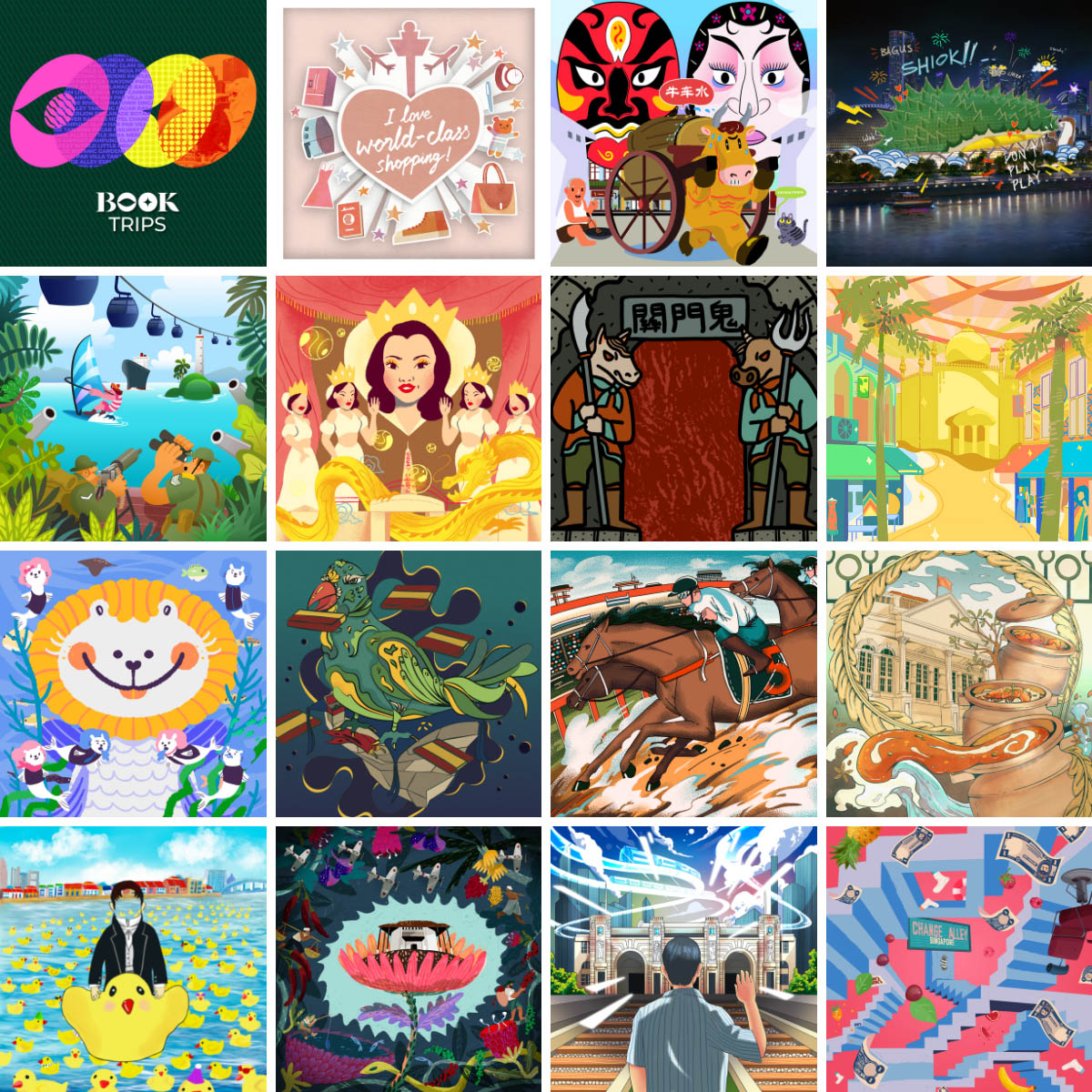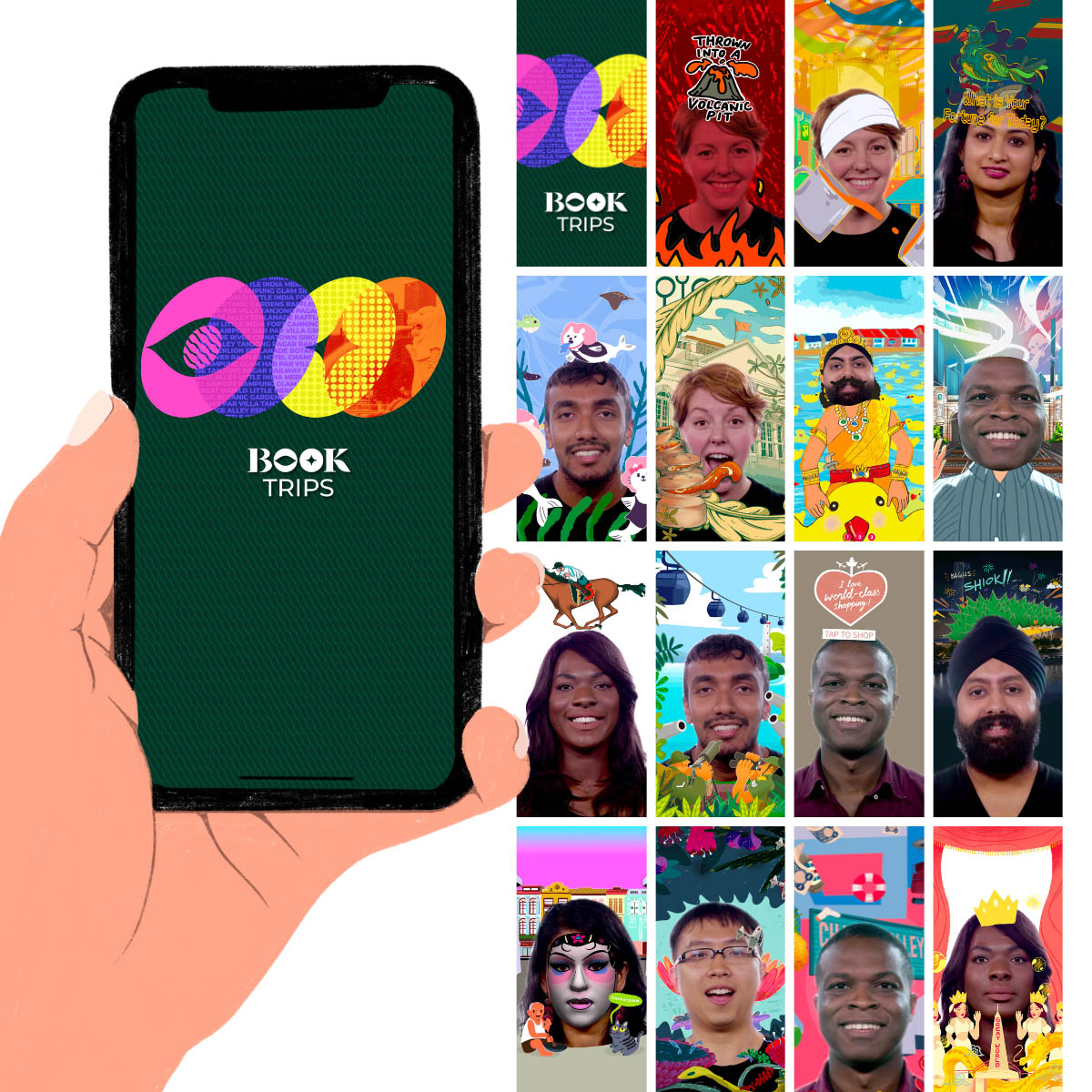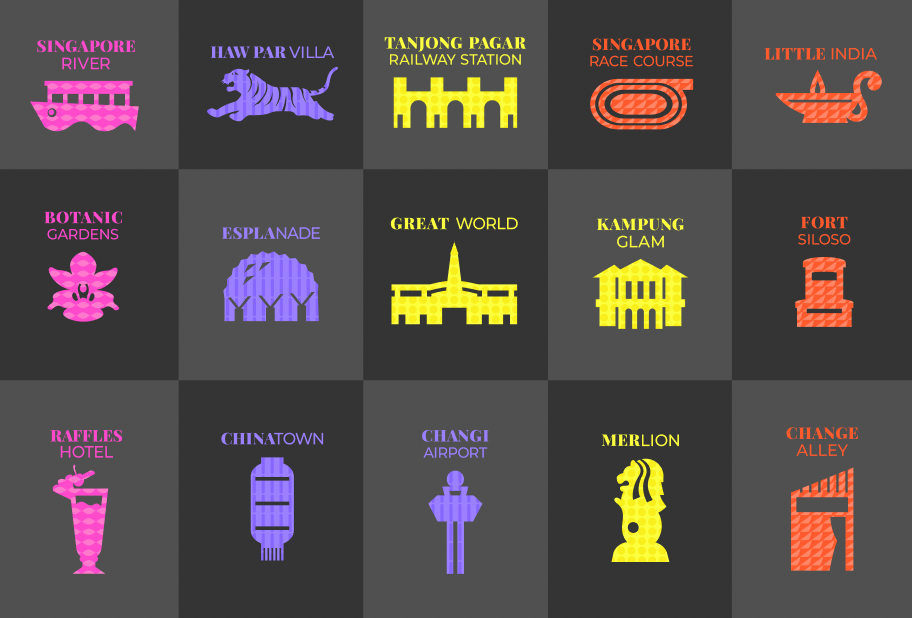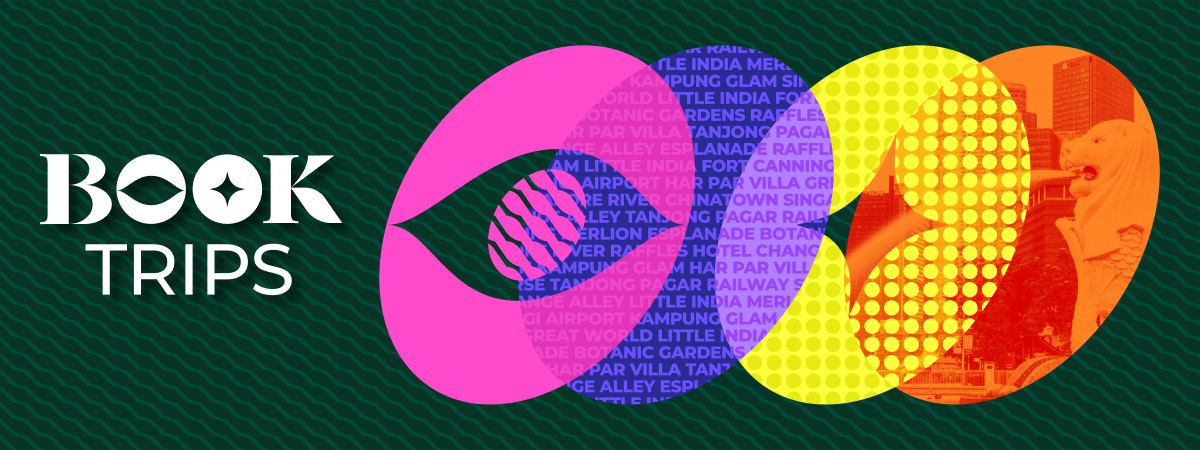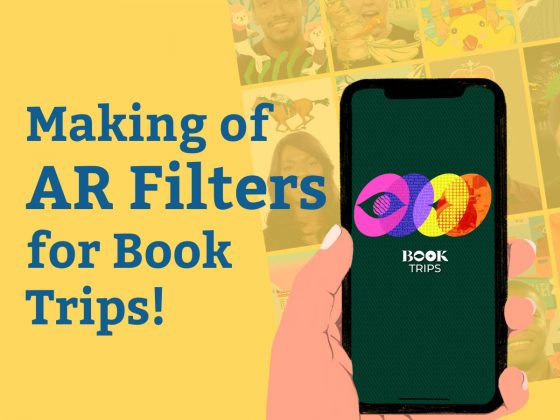
Making of AR Filters for Book Trips!
Written by: samantha
In Tusitala’s recent project, Book Trips, we created AR filters for each of the 15 past and present attractions featured in an online literary map of Singapore.
A year ago, we created Local Flavours for Singapore HeritageFest 2021, featuring 15 local poems about hawker food. To present the poetry in a way that reflected their content, users could “order” poems off a menu through a website. Each poem came with an insightful article about the food’s history, a recipe, as well as a digital sticker pack that could be downloaded and used on Telegram or WhatsApp. (They’re still available! Check them out here).
For Singapore HeritageFest 2022 we created Book Trips, a microsite designed to take users on a literary virtual tour around 15 past and present attractions.
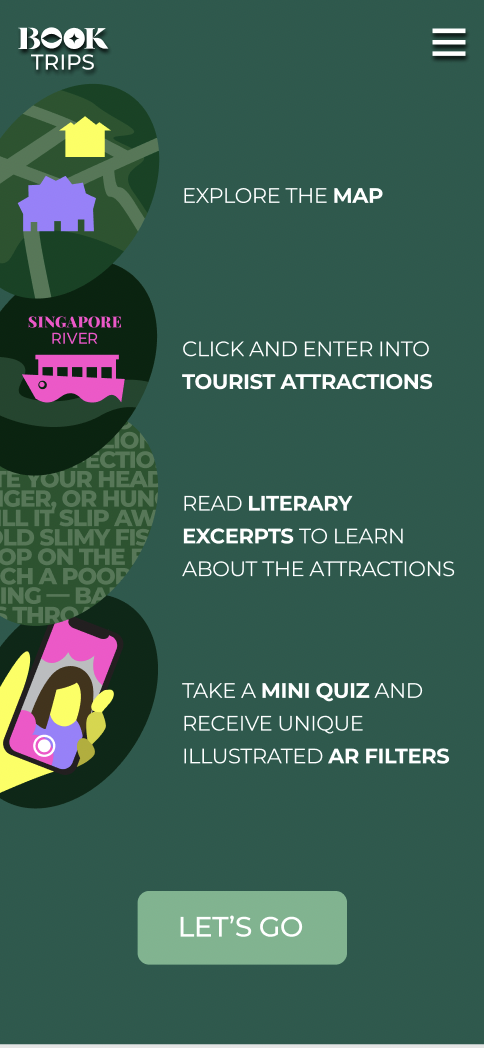
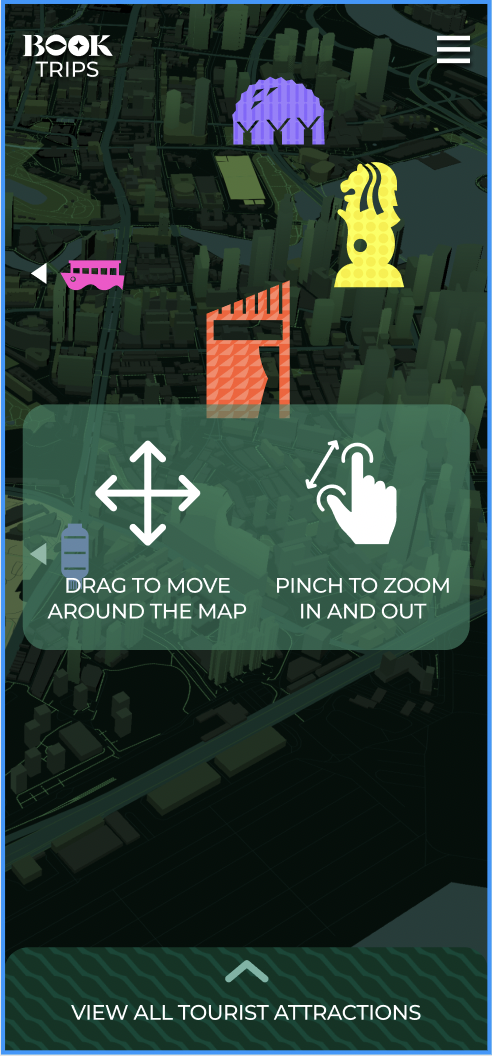
As part of the tour users can read a book excerpt set in the attraction, take a quiz related to the excerpt, and collect AR filters based on the attraction. To emphasise the project’s literary content and the wonder of exploring Singapore, we wanted each AR filter to be a visual representation of their book excerpt.
This was accomplished effectively with the help of 15 talented local illustrators who participated in this project by making AR filter artwork.
Why AR Filters?
When conceptualising Book Trips for this year’s festival, our team had similar aims in mind: we wanted to share interesting slices of history with people, and to do so in a way that matched medium to message.
In the process of diving deeper into the history behind these places, we started to imagine ourselves as virtual tourists in our own country.
Since photo-taking is something we often do when travelling, this naturally gave rise to the idea of creating AR filters specific to each featured attraction. We thought the AR filters could offer a fun spin on a familiar action that is such a big part of travel and tourism.
AR objects and filters also gave us the opportunity to represent places that no longer exist. For example, Change Alley used to be a bustling bazaar for trade in goods from diverse cultures. Today it is a clean and modern alley with swanky cafes and eateries visited by lunch hour business crowds instead of the traders of yesteryear.
By recreating the tourist experience through filters and photo taking, our hope was that readers might also experience the book excerpt differently – by first envisioning themselves in the setting of an excerpt, then relating that fictional setting to the real world location that inspired it.
Exploring the Potential of AR
Inherent to AR is the ability it gives users to interact with and respond personally to the location. The range of interactions that could be performed with AR filters was another characteristic we were keen to explore.
Each AR filter could contain a unique interaction that suited its respective excerpt and location, allowing users to rediscover these places in a fun way.
Creating the filters
When conceptualising AR filters in response to the excerpts, it was essential for the illustrators we engaged to not only create art that represented the excerpt or location well, but to also think about opportunities for interactions to engage users.
Tusitala’s designers conducted online briefings with the illustrators to convey the objectives we wanted to achieve. As some artists unfamiliar with AR opted out of creating the SparkAR filters, many of the filters were created in-house by our team.
This was our first venture into making AR filters as a team, and the process required extensive collaboration and troubleshooting. One challenge we had was the need to separate artwork into layers suitable for AR filter creation.
Though a tedious process, we successfully transformed illustrations submitted into the interactive filters envisioned.
Bringing Stories to Life
It was a fun challenge to work on 15 different filters, and we wanted to provide some variety in the experience offered across these.
This was done by making the filter’s artwork distinctive and allowing users the chance to play with a range of interactions:
- users had to tap (Great World and Tanjong Pagar)
- or move their heads to trigger interactions and animations (Botanic Gardens and Esplanade)
- or they could pinch their screens to move or resize an AR object and place it in their surroundings (Singapore Racecourse)
Furthermore, in order for these interactions to be meaningful they had to relate well to the book’s content.
For instance, The Devil’s Garden describes a fictional life in the Botanic Gardens during WWII, where workers turned to the gardens as a source of sustenance and raw materials. Here, the motion of looking up when using the Botanic Gardens filter parallels an additional concern experienced by workers in wartime.
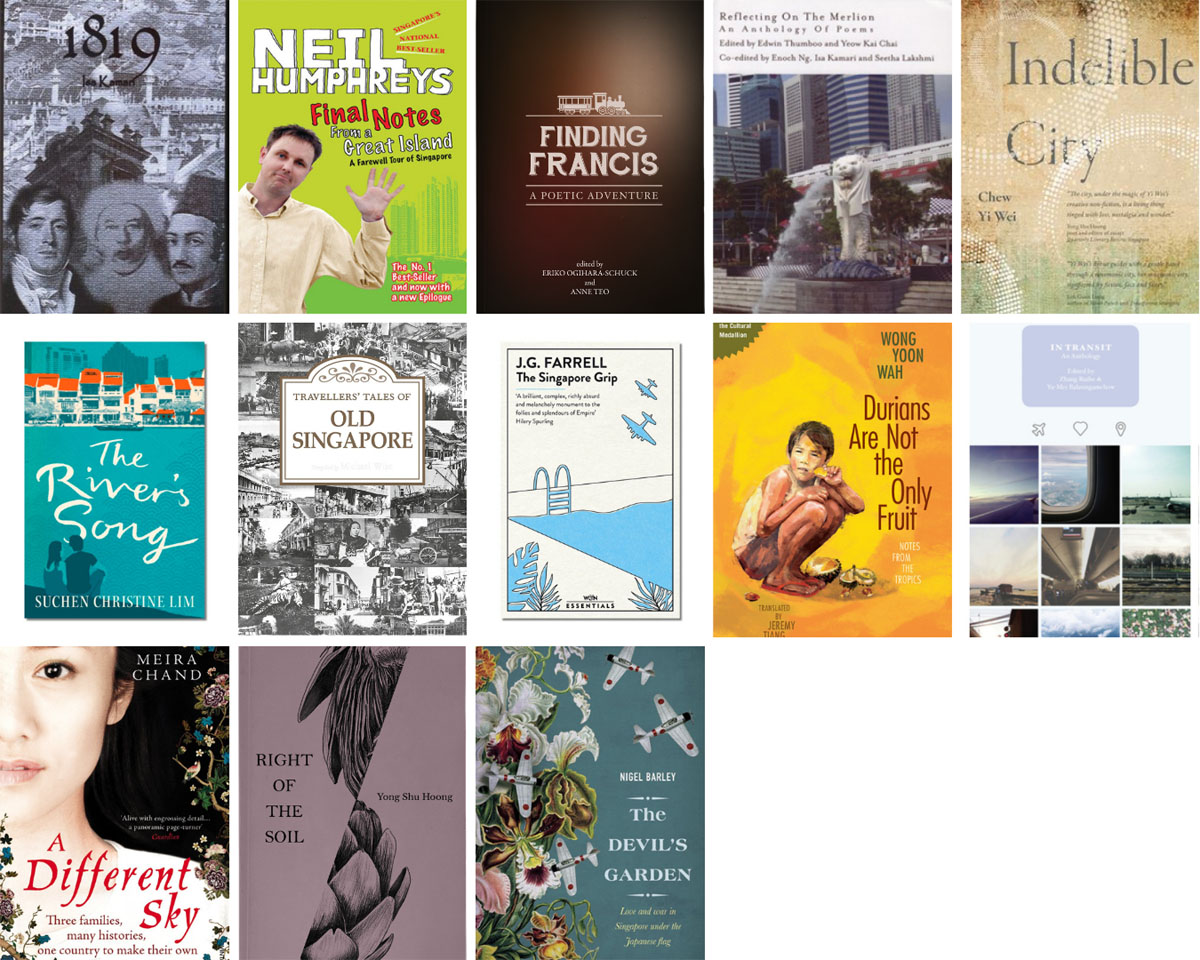
All Book Trips AR filters were based on local artists’ interpretations of the excepts from these books
AR filters – A passing trend or something to stay?
It’s hard to say if the widespread and increasing use of social media translates into greater use of AR filters, but we are curious to see where this trend will lead and remain optimistic about the future of AR more broadly
Current AR technology already provides creatives a variety of ways to engage users through interactive features.
AR filters are only a small foray into the vast world of potential AR experiences, and – for both Tusitala and the illustrators we work with – we hope this project will be a stepping stone to bigger, more daring experiments with the technology.
Come explore Singapore through our literary map!
Read the excerpts, play simple mini-quizzes, and take touristy photos with our 15 AR filters created by local artists.
BOOK TRIPS by Tusitala
A programme of the Singapore HeritageFest 2022
2 – 29 May 2022
https://booktrips.tusitalabooks.com
About Tusitala
Tusitala is a digital storytelling studio that reimagines the future of reading where tech meets art. We use our expertise in technology, user experience, and design to transcend the traditional boundaries of print and digital.
About Singapore HeritageFest
The Singapore HeritageFest (SHF) is the National Heritage Board’s signature annual outreach event that celebrates the many facets of Singapore’s diverse heritage and culture. SHF works with individuals, groups and communities to co-create programmes and offerings. This allows the festival to uncover lesser-known stories and narratives, engender a greater sense of ownership, and empower Singaporeans to safeguard and promote our shared heritage. The inaugural edition of SHF was staged in 2004, and since then, the festival has continued to provide on-site and online experiences with yearly themes that focus on different aspects of Singapore’s heritage.
Featured Locations / Book excerpts / Illustrators
Location |
Publication / Work |
Year |
Author |
Genre |
Publisher |
AR Filter Illustrator |
|
1 |
Fort Siloso |
Final Notes from
|
2006 |
Neil Humphreys |
Essay |
Marshall Cavendish |
Don Low |
2 |
Merlion |
“Conversation
|
2009 |
Paul Tan |
Poem |
NAC |
Joy Ho |
3 |
Esplanade |
“Two Harbours” |
2018 |
Chew Yi Wei |
Essay |
Marshall Cavendish |
Ray Toh |
4 |
Botanic Gardens |
The Devil’s Garden |
2013 |
Nigel Barley |
Novel |
Monsoon Books |
Eliz Ong |
5 |
Singapore River |
“The Singapore River” |
2009 |
Latha |
Poem |
NAC |
Patrick Yee |
6 |
Raffles Hotel |
“Feed at the Raffles” |
2013 |
Wong Yoon-wah |
Essays |
Epigram Books |
Claire Low |
7 |
Changi Airport |
“Ramblings of
|
2016 |
Ng Seow Hwee |
Short story |
Math Paper Press |
Andrew Tan
|
8 |
Great World |
Singapore Grip |
1978 |
J. G. Farell |
Novel |
Weidenfeld
|
Rachael Lum |
9 |
Tanjong Pagar
|
“F.M.S.R” |
2014 |
Teo Poh Leng |
Poem |
Ethos Books |
Araikreva |
10 |
Haw Par Villa |
“II. The Spa at
|
2018 |
Yong Shu Hoong |
Poem |
Ethos Books |
Anngee Neo |
11 |
Singapore
|
“The Daily Double” |
1934 |
J. Douglas Graham |
Travel
|
Marshall Cavendish |
Charmaine Tan |
12 |
Chinatown |
The River’s Song |
2014 |
Su-chen Christine Lim |
Novel |
Aurora
|
James Tan |
13 |
Kampong Glam |
1819 |
2013 |
Isa Kamari |
Novel |
Silverfish Books |
Teo Wenn Ki |
14 |
Little India |
A Different Sky |
2010 |
Meira Chand |
Novel |
Penguin |
Eugenia Hoy |
15 |
Change Alley |
“An Eastern
|
1931 |
R. N. Walling |
Travel writing |
Marshall Cavendish |
Muhammad Izdi |

